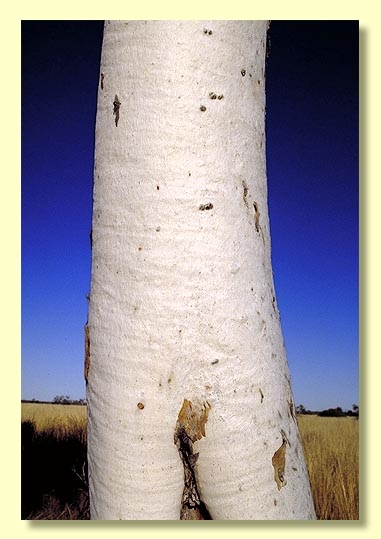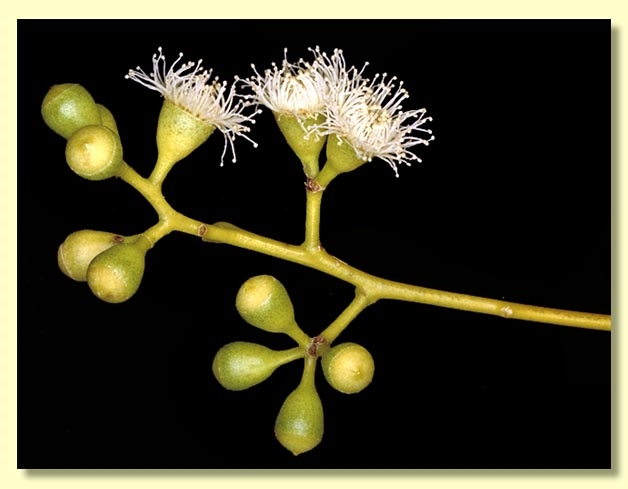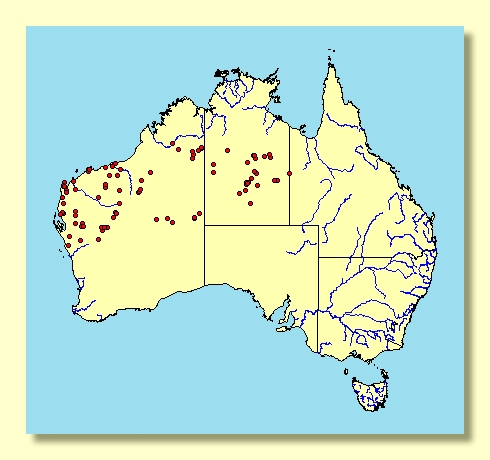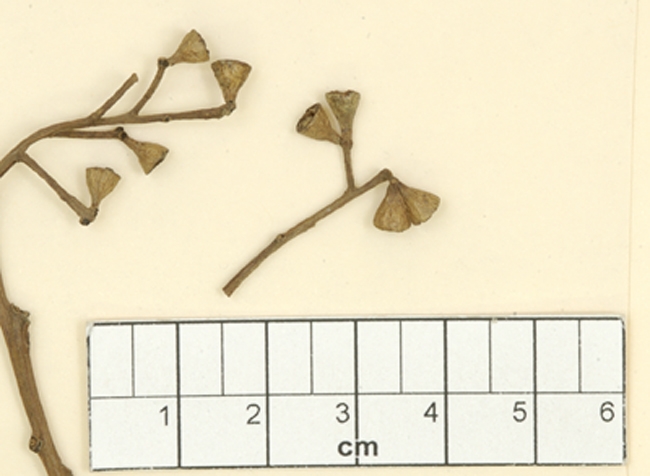Euclid - Online edition
Eucalyptus victrix
Eucalyptus | Symphyomyrtus | Adnataria | Apicales | Aquilonares | Protrusae
Eucalyptus coolabah var. rhodoclada Blakely, Key Eucalypts 246 (1934). T: Milly Soak, near Cue, W.A., Sept. 1903, W.V.Fitzgerald s.n.; holo: NSW; iso: BM, CANB, K, NSW, PERTH.
Bark smooth throughout, pure white and powdery, some patches of older bark reddish to brown.
Branchlets non-glaucous or, more rarely, glaucous; lacking oil glands in the pith.
Juvenile growth (coppice or field seedlings to 50 cm) stems rounded in cross-section, non-glaucous or glaucous; juvenile leaves always petiolate, opposite for 1 or 2 nodes then alternate, broadly lanceolate, 8–12.5 cm long, 3–4.5 cm wide, base rounded or tapering, dull grey-green.
Adult leaves alternate, petiole 0.7–2.3 cm long; blade lanceolate to falcate, (7.8)9–15(22) cm long, 0.8–2.5(3.5) cm wide, base tapering to petiole, margin entire, apex pointed, concolorous, dull, light green to grey-green, side-veins greater than 45° to midrib, reticulation very dense, intramarginal vein present, oil glands apparently absent.
Inflorescence terminal compound, peduncles 0.1–1.3 cm long; buds 7 per umbel, pedicels 0.1–0.3 cm long, rarely subsessile. Mature buds ovoid to obovoid, 0.3–0.5 cm long, 0.2–0.3 cm wide, glaucous or green, scar present (outer operculum falling early), operculum conical to more or less rounded, stamens inflexed or irregularly flexed, anthers cuboid to globular, adnate, basifixed, dehiscing by lateral slits, style long and straight, stigma blunt, locules 3 or 4, the placentae each with 4 vertical rows of ovules. Flowers creamy white.
Fruit on pedicels 0.1–0.3(0.5) cm long, rarely sessile, obconical narrowing slightly at the top, thin-walled, 0.2–0.5 cm long, 0.3–0.6 cm wide, disc narrow, descending or apparently absent, valves 3 or 4, exserted or at rim level, curving inwards.
Seeds brown, lustrous, 1–2 mm long, ovoid and faintly angled to flattened-ovoid, dorsal surface shallowly reticulate, hilum ventral.
Cultivated seedlings (measured at node 10): cotyledons oblong-reniform; stems square in cross-section, glaucous or non-glaucous; leaves always petiolate, opposite for 3 or 4 nodes then alternate, lanceolate, 5–12.5 cm long, 1–4.5 cm wide, dull grey-green.
Flowering has been recorded in July, August and November.
A small tree occurring in Western Australia and Central Australia, from Murchison River north to North West Cape and east through the Gibson, Great Sandy and Tanami Deserts to Tea Tree and Tennant Creek, extending further east to the Georgina River (Lake Nash Station) near the Queensland border. Eucalyptus victrix is found in the arid zone on low-lying areas of red clay or clay loam subject to irregular flooding, and usually has smooth white powder-bark trunks, dull grey-green to green leaves, terminal inflorescences and fragile fruit with incurved valves on the open fruit. They soon shed their seed after fruit maturity.
E. victrix is closely related to E. coolabah, E. microtheca and E. acroleuca. It is distinguished within this group by its (usually) completely smooth-barked trunk and the incurved valves of the open fruit. Both E. coolabah and E. acroleuca have basal rough bark and conspicuously smooth-barked upper trunks and branches. If E. victrix has rough bark then it is only on basal ca 1 m of trunk, and seems to be only on plants in the Pilbara. E. microtheca is fully rough-barked to the small branches.
Eucalyptus victrix may be mistaken for river red gum (E. camaldulensis subsp. arida and subsp. refulgens) but the latter have axillary, not terminal, bud clusters, adult leaves with oil glands visible, non-fragile fruit with a prominent disc and strongly exserted valves, and often non-powdery smooth bark. E. camaldulensis subsp. arida and subsp. refulgens are found close to permanent or seasonal fresh-water streams in arid areas where rainfall is slightly more reliable than the harsh sites where E. victrix is found.
In the classification of Brooker (2000) Eucalyptus victrix belongs in Eucalyptus subgenus Symphyomyrtus section Adnataria (the boxes) because the buds have two opercula, ovules are in four rows, seeds are flattened-ovoid, cotyledons are reniform, and anthers are rigid on the staminal filaments. Within section Adnataria, E. victrix belongs to a subgroup of box species with mostly tropical distribution, series Aquilonares subseries Protrusae, having inflorescences terminal on the branchlets, adult leaves very densely reticulate and fruit that are small, fragile and some have exserted valves.

















